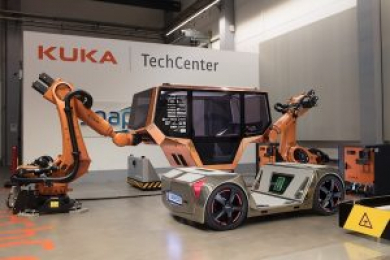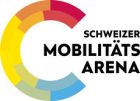Rinspeed microSNAP shows scaled-down modularity, automated body-swaps
Swiss design consultancy Rinspeed will present a scaled-down version of its Snap concept at CES, Las Vegas, in January
microSNAP has been shrunk to “the dimensions of a Renault Twizy”, the company says, to propose a modular micro-mobility solution for last-mile applications. Like the larger Snap, seen in Vegas last year, microSNAP has a skateboard chassis structure with snap-on, snap-off body ‘pods’ to suit different purposes. The concept of both Snap and microSNAP has been developed with autonomy in mind, including two-seater ‘robo units’ for quick on-demand transportation as well as ‘just-in-time’ delivery vehicles. “Customers increasingly want prompt deliveries, and many passengers are unwilling to use shared taxis, which have to take time-consuming detours,” explained company chief Frank M. Rinderknecht in a Statement.
The skateboard/pod design has the additional advantage of easier updating of specific components: the skateboards containing all the hardware, electronic and connected technologies, for example, are more prone to obsolescence than the body units, and can be recycled and replaced at different times. Rinspeed will also demonstrate a new automated robot station, created by Kuka, for pod-swapping.
As per usual with Rinspeed’s concept cars, the microSNAP showcases a range of technologies and services from leading suppliers. These include lighting technology with a digital license plate and micro-pixel LEDs for communication, by Osram; a 48-volt electric traction motor by Mahle; input on software platforms for automated driving from Luxoft; connected-car apps and UX/UI design for the HMI by Estonia’s Bamboo Apps; AI-enhanced and blockchain-supported automated fleet and intermodal transport ecosystem platforms and software co-ordinated by MHP, SAP and EY Advisory; a drive-by-wire system from Bozzio; and bio-sensing seats from Lear. Iris-scanners for occupant recognition, interior monitoring sensors and dimmable glass windows come from Gentex; and laser sensors for automated driving from Ibeo, with antennae from NXP.

13. Dezember 2018
AUTOMAT VOR ORT: KONFERENZ AUTOMATICAR 2020
Am 16. September findet der Fachkongress AUTOMATICAR zum 2. Mal änlässlich der ...
»weiterlesenAUTOMAT vor Ort: Konferenz AUTOMATICAR
Am 12. April fand das erste Mal die von der Mobilitätsakademie des TCS organisierte ...
»weiterlesenAutomat vor Ort: EPTA Conference 2017
EPTA Conference 2017 „Shaping the Future of Mobility“ Luzern, Verkehrshaus, Mittwoch, 8. ...
»weiterlesenAuto-mat vor Ort: Automatische Shuttlebusse tpf
Am 22. September war www.auto-mat.ch live vor Ort, als die ersten beiden automatischen ...
»weiterlesen


